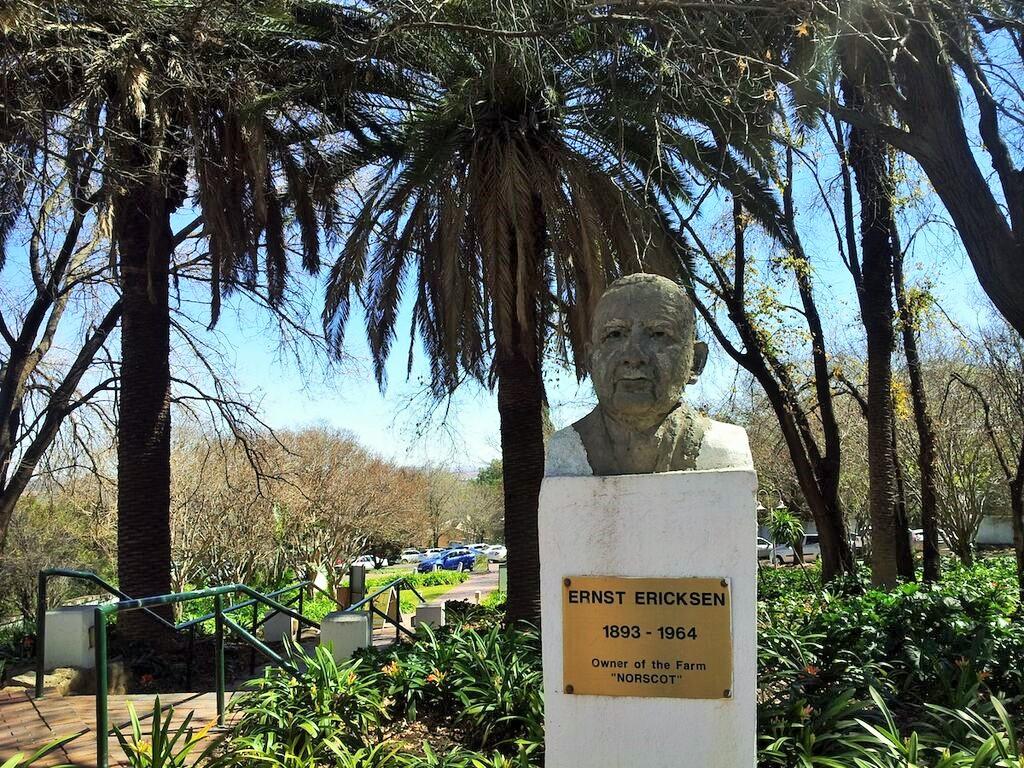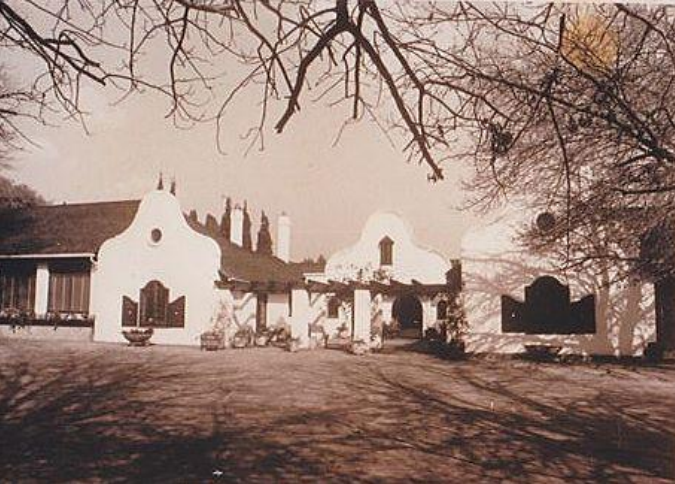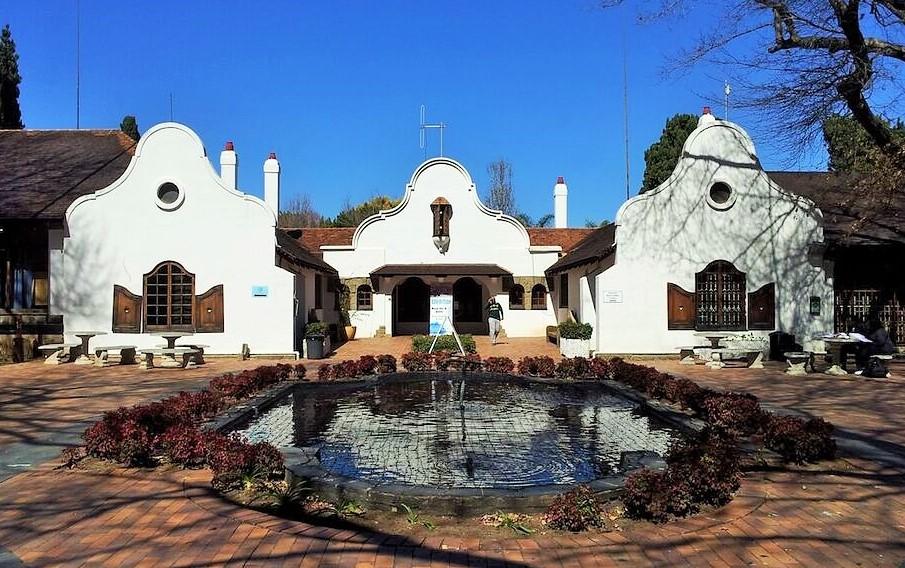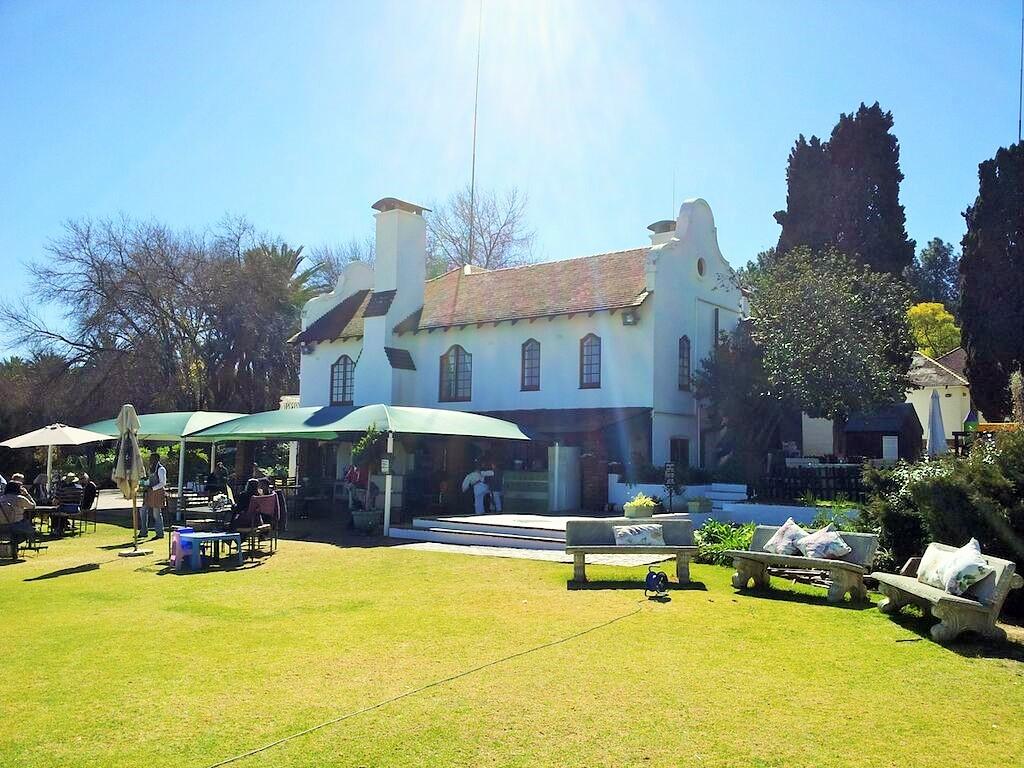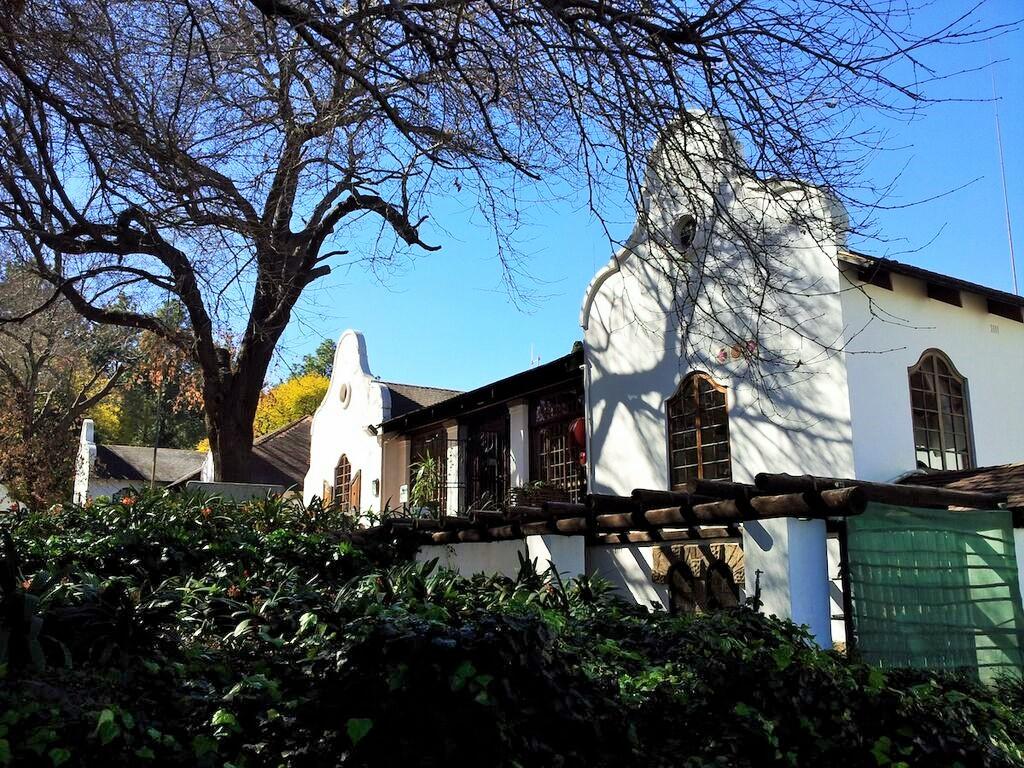
Disclaimer: Any views expressed by individuals and organisations are their own and do not in any way represent the views of The Heritage Portal. If you find any mistakes or historical inaccuracies, please contact the editor.
Norscot Manor lies to the north of Sandton, west of the William Nicol Drive and just north of the N1 Motorway. The home of the Eriksen family until 1982, Norscot now belongs to Sandton who have developed it as a community centre to serve their northern suburbs, and have already made one wing into a Public Library. Norscot was built in 1936 on a scale few could afford today and was ideally suited to lavish entertaining as well as being the quiet secluded home the Eriksen's wanted. As for its name, NORSCOT, we know that the "nor‟ was for Norway and "scot‟ was for Scotland and that Mr and Mrs Ernst Eriksen lived there with their two children [The family's phenomenal wealth came largely from its success in the motor industry].
The first house the Eriksens lived in in Johannesburg had been the stables of what is now the Hope Home in Westcliff. It was a stone house, designed by Sir Herbert Baker, which they rented from the well-known South African authoress Sarah Gertrude Milne. While there, they looked around for somewhere to build a permanent home. And it was while driving out to the north towards the mountains that they came across the water-melon farm belonging to Chris van der Walt and his brother near what is today the Sandton suburb of Fourways. Thus it was that plans evolved for the building of the second Norscot (their house in Kloof, Natal, had also had that name).
Bust of Ernst Eriksen at Norscot Manor (The Heritage Portal)
The Building of Norscot
It was in 1935 when the Eriksens had first seen the land to the north of Johannesburg, and Ethel Eriksen decided there and then that 'this is where I want to build my home'. She had been captivated by the glorious open view to the north, with the land sloping away towards the Magaliesburg Mountains, and by the superb sunset.
The very next day Ernst Eriksen set out to find out more about the land, and it was then that he met the van der Walt brothers. The land was part of the original farm of Witkoppen which had been proclaimed as long ago as 1856 and granted to Van Vuuren. By the 1900s much of the original farm land had been in the hands of the van der Walt family for some years and, as mentioned before, was then being used as a water-melon farm, as well as for breeding Friesian cattle.
Ernst Eriksen introduced himself to the owners, and sat and had coffee with them, and before long he had persuaded them to sell 423 acres. Further acres were added at a later stage as they came up for sale, and "Norscot" eventually comprised 605 acres. Needless to say, Ethel Eriksen was delighted, and work soon started on the first part of the project.
Ernst Eriksen lived in a tent at the site during the initial building, and already 'the Cottage' - comprising the two central wings with a courtyard joined by a fence and small central gate - was ready to move into by July 1936. The original 'Cottage' had been built by the builders Thomas Clarke, but all further work was carried out by Swiss master-craftsman Gottfired Heddinger over a period of ten years. Mr Heddinger lived in a flat at the property while supervising the work.
First Class craftsman were employed, and everything possible was done to produce a building of the very highest possible standards. When the house was sold in 1982 it was described as having: '8 elegantly proportioned reception rooms designed for entertaining on a lavish scale. There are 6 bedrooms, 5 bathrooms and ample domestic offices. Total area under roof, excluding outbuildings: 1,200 sq metres.'
An early photograph of Norscot Manor
Ernst Eriksen was an outgoing congenial man who loved entertaining, and his wife Ethel had very definite ideas about the style and the quality she wanted. The result was the ideal house, where receptions and parties were easy to handle ... and during its heyday Norscot saw many happy gatherings. The fine downstairs Tavern, which had been opened to celebrate Ernst Eriksen's 50th birthday on April 6th, 1943, was much used as was the large 'braai' area outside.
Ernst Eriksen had always been keen on music, and liked to have a violinist on hand at his parties to serenade the ladies. The house was always filled with people, especially sportsmen and politicians. Norscot was the expression of the personalities of both Ernst and Ethel and was well used. It should be remembered that through the 1950s, Norscot was still very much a 'country house'. Sandton and Randburg were undeveloped, and the William Nicol Drive only came towards the end of the 1950s. Access to Norscot was still via Ferndale and Hendrik Verwoerd Drive, and the whole area around the house was still regarded by Johannesburg as being 'out in the sticks'.
A more recent shot of Norscot Manor (The Heritage Portal)
The Entrance and Hall
Access to Norscot used to be across the courtyard, where bright bougainvillea would twine around gum poles, and then through a shady porch into the spacious panelled reception hall. Today, the entrance is through what used to be the Sunroom or the Family Room, and into the lounge and hall from the west end. Apart from its fine panelling, the Hall still retains its outstanding feature, the elegant carved fireplace, which had come from the Parktown Home of Sir Julius Jeppe, one of Johannesburg's Randlords. The fireplace is still the main feature of what is today a gallery for some of WSSA's art collections. The stained glass in other parts of the house (Billiard Room and Tavern) also came from the Julius Jeppe house when it was demolished. The glass was remodelled by Herbert Evans.
More fireplaces
Fireplaces are a great feature of Norscot, there are eleven open ones many of them the flat raised type of Norwegian style. The stone fireplace in the original dining room is of particular interest because the granite came from the nearby Norscott Kopie. This Koppie, now owned by the Sandton Municipality as a Bird Sanctuary and Nature Reserve, was originally in two parts. The smaller section had been owned by a company called Waterman & Amery, and the larger part had belonged to a man called Mr James. Not much more is known about these original owners, but we do know that they were bought by Erns Eriksen and added to the Norscot Estate. Of special note is an old tree near the reserve, a thorn Acasia Sieberana, which is around three hundred years old.
Another fireplace of special interest is the one in what used to be the Guest Wing, now the Public Library. The tiles surrounding it (made by Cullinans of Olifantsfontein) were brought out to commemorate the 'Great Trek Centenary' in 1936 and include drawings of ox-wagons and other 'trek' subjects. There is also a fine moulded fireplace in the west bedroom, which was Ethel Eriksen's room, - from where she could see her fine sunsets and the glorious mountains. It is now to be called the "Troon" room.
Airbricks and moulding
Also of special note are the elegant 'airbricks', also made by Cullinans of Olifantsfontein. They are all moulded with open animal designs and are to be found in other houses of the period. The Viking Ship mouldings in the tavern downstairs, were also by Cullinans, as was the Norwegian Lion moulding over the fireplace in the Master Bedroom to be called the "Stavanger" Room.
Lights
Fitted lights and lampshades add another interest to the house. First there are the wooden carved ones which came from Norway and then there are the glass enclosed ones in the sunroom. The bathroom light fittings are worthy of mention, being of art-deco styled glass and moulded into shell shapes. Fortunately, these have been retained as they blend so well with the period of the house.
Norscot woodwork
Visitors to the house should notice quality woodwork all supplied originally by Hunt, Leuchars and Hepburn, the old established Mining Timber Company. Teak was used for all the windows and oregon pine for the rafters. The floors were of panga-panga, a very hard wood that comes from Central Africa. The detailed carving at Norscot such as the alcoves and the Viking Ship Bar in the downstairs Tavern was all done by a craftsman carver, Mr Harcus, who also did all the carving at 'Libertas', the official residence of the State President. Harcus came from the Hebrides and used to sit at work singing laments which would make Ethel Eriksen ask him if he could not sing something more cheerful. He also carved fine replicas of the Scottish and Norwegian lions, and the South African coat of arms which were over the billiard room fireplace when the family was in residence. These carvings have been replaced by lights, and the originals are now in Mrs van Wyk's Bryanston home as sentimental reminders of her time at Norscot.
Wrought iron work
Specially made by the Rand Wrought Iron Works is the fine Juliet Balcony which is a feature of the main bedroom in the west wing. This was Ethel Eriksen's bedroom, now called the 'Troon' room after the Scottish town of her birth. The stairway balcony and those in the 'Tavern' are a replica of those in the Spanish Embassy in London.
Over the years, Ethel Eriksen had acquired wide knowledge and experience of furniture, art and decoration, and during travels in many parts of the world, she built up an exceptional private collection. Her pewter collection was among the finest anywhere. Once, when they went to Hong Kong, her husband had to get crates specially built for her purchases, and another time when they were touring the English countryside she bought a table which had to remain on her car roof for the rest of their trip until they got back to London. Ethel Eriksen furnished the house with her husband in mind. He was a very big man and she felt that he needed sturdy objects around him. She started collecting antiques in 1925 and had an extraordinary eye for quality. Norscot became, not only a home, where great parties and social gatherings took place (Ernst Eriksen was a congenial man and an excellent host) but also an elegant residence, the expression of a woman with fine taste backed by vast knowledge...
Times change
...in the meantime, it was becoming more and more difficult to maintain the Norscot property and the loyal staff were all reaching retirement stage. Mrs Ethel Eriksen survived her husband by fourteen years [he died at the age of 71], and passed away at the age of 84 in 1978. It was then that their daughter, now Mrs Joyce van Wyk, decided to sell the property. The sale at Norscot was almost the social event of the year in 1982 when a large marquee was erected on the west lawn to handle the proceedings. With viewing over three days - February 5th, 6th and 7th, and the actual auction on the 8th, 9th and 10th, over 3,300 people attended and over 3,000 items were offered for sale. It was described as the largest house sale in the Southern Hemisphere and, South Africa's rich and famous were all represented, among them Dr Chiavelli, Gary Player and Barbara (then) Barnard.
The Norscot Lawns (The Heritage Portal)
Many spectacular items collected by the Eriksens were on sale, including four Anton von Wouw bronzes, three early 19th Century paintings of Table Bay, two Frans Oerders, the maquette for John Tweeds famous statue of Cecil Rhodes and a rare Peter Wenning 'Still Life'. There was also a stinkwood 'armoire' which had belonged to Sir Lionel Philips at Vergelegen and the Tweed maquette that had belonged to Sir Abe Bailey and had been bought at Muizenberg in 1951. The original Rhodes statue stood for many years in the centre of Bulawayo. Reminiscent of Ernst Eriksen himself, the sale also included a rare 1964 Lincoln Continental 4-door convertible, which had been imported especially for the Erikesen family. The beautiful antique (1812) carved cradle which had been filled with flowers as a floral arrangement at the famous 1953 Rand Club Coronation Ball was also sold. Many of the rare items were retained by Mrs Van Wyk because of their sentimental associations.
The original farm, which had stretched as far as today's Fourways crossing, was split up, although a small portion was kept by Mrs van Wyk. Most of the land which was put up for sale was purchased by developers Schachat Cullum, and has become the new suburb of 'Norscot Manor'. The house, with 11 hectares was finally sold to the Sandton Municipality several years later, following representations from local groups.
Comments will load below. If for any reason none appear click here for some troubleshooting tips. If you would like to post a comment and need instructions click here.

